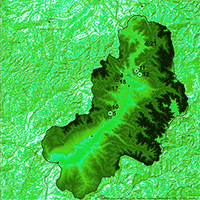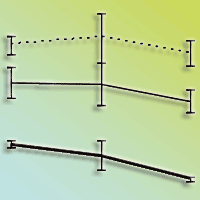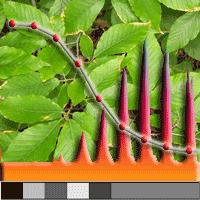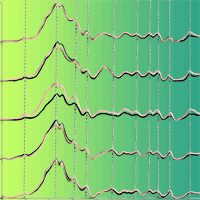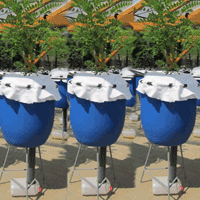
Evaluation of fast growing tree water use under different soil moisture regimes using wick lysimeters
D Mantovani (1-2) , M Veste (3), A Badorreck (2), D Freese (2)
iForest - Biogeosciences and Forestry, Volume 6, Issue 4, Pages 190-200 (2013)
doi: https://doi.org/10.3832/ifor0100-006
Published: May 08, 2013 - Copyright © 2013 SISEF
Research Articles
Abstract
The cultivation of fast growing trees has high potential for bioenergy production on marginal lands. Information about the water use efficiency in combination with the ecophysiological response to drought stress is still incomplete. For the study of the transpiration-biomass relations satisfactory results can be obtained under controlled conditions by using lysimeters. Nonetheless, several technical problems related to the manufacturing can bias the outcome. Pan lysimeters are economical and relatively easy to assemble, however, saturation at the lower boundary can happen. On the other hand tension lysimeters, where the suction is applied by a vacuum pump, are effective but expensive and need constant maintenance. To avoid stagnancy and reduce production costs we assembled a tension controlled wick lysimeter, where the tension at the bottom layer is actively exerted by a hanging water column through the wick material (rockwool). We aim to assess the performance of the wick lysimeter coupled with an automatic irrigation system for the study of water use-yield relation black locust (Robinia pseudoacacia L.) under different irrigation regimes. The volumetric soil content for each treatment, namely low water (LW), medium water (MW) and high water amount (HW), was maintained at 0.07, 0.14 and 0.2 m3 m-3 respectively. During the vegetation period (161 days) the plants growing at LW reduced their water use by 60%, their leaf area by 40% and the total above ground biomass by 46%. As a result, we found a linear correlation (R2 = 0.98) between the relative biomass produced and the relative water use. The calculated relative water use efficiency (RWUE) for black locust total above ground dry biomass is 0.96. Furthermore, after the harvest we evaluated the effectiveness of the lysimeter and irrigation system: the soil moisture of the treatments was kept up at the predefined values and an unsaturated condition at the boundary layer was maintained throughout the vegetation period. Because of the improved design no roots grew into the drainage extension and no unexpected change of the lysimeters hydraulic property occurred. Considering the relatively low-cost material used and the low maintenance needed, compared to other tension controlled lysimeters, wick lysimeters are effective tools for forestry studies of young trees.
Keywords
Black Locust, Soil Moisture Dynamic, Unsaturated Conditions, Hydrostatic State, Wilting Point, Relative Water Use Efficiency
Authors’ Info
Authors’ address
Brandenburg University of Technology, International Graduate School, Konrad-Wachsmann-Allee 6, D-03046 Cottbus (Germany)
A Badorreck
D Freese
Brandenburg University of Technology, Chair of Soil Protection and Recultivation, Konrad-Wachsmann-Allee 6, D-03046 Cottbus (Germany)
Centre for Energy Technology Brandenburg e.V., Friedlieb-Runge-Str. 3, D-03046 Cottbus (Germany)
Corresponding author
Paper Info
Citation
Mantovani D, Veste M, Badorreck A, Freese D (2013). Evaluation of fast growing tree water use under different soil moisture regimes using wick lysimeters. iForest 6: 190-200. - doi: 10.3832/ifor0100-006
Academic Editor
Roberto Tognetti
Paper history
Received: May 04, 2012
Accepted: Feb 11, 2013
First online: May 08, 2013
Publication Date: Aug 01, 2013
Publication Time: 2.87 months
Copyright Information
© SISEF - The Italian Society of Silviculture and Forest Ecology 2013
Open Access
This article is distributed under the terms of the Creative Commons Attribution-Non Commercial 4.0 International (https://creativecommons.org/licenses/by-nc/4.0/), which permits unrestricted use, distribution, and reproduction in any medium, provided you give appropriate credit to the original author(s) and the source, provide a link to the Creative Commons license, and indicate if changes were made.
Web Metrics
Breakdown by View Type
Article Usage
Total Article Views: 65826
(from publication date up to now)
Breakdown by View Type
HTML Page Views: 54850
Abstract Page Views: 3944
PDF Downloads: 5120
Citation/Reference Downloads: 21
XML Downloads: 1891
Web Metrics
Days since publication: 4610
Overall contacts: 65826
Avg. contacts per week: 99.95
Citation Metrics
Article Citations
Article citations are based on data periodically collected from the Clarivate Web of Science web site
(last update: Mar 2025)
Total number of cites (since 2013): 8
Average cites per year: 0.62
Publication Metrics
by Dimensions ©
Articles citing this article
List of the papers citing this article based on CrossRef Cited-by.
References
Wachstumsverlauf von vierjährigen Robinien. Allgemeine Forstzeitung - Der Wald 10: 532-533.
Gscholar
Assessing the short rotation woody biomass production on marginal post-mining areas. Journal of Forest Science 57 (7): 303-311.
Gscholar
Weighing lysimeter for crop water use determination in the Jordan Valley, Jordan. American Society of Agricultural and Biological Engineers 52 (1): 155-169.
Gscholar
Economics of trees versus annual crops on marginal agricultural lands. Oxford & IBH Publishing Co., New Delhi, India.
Gscholar
Research on water changes and water use efficiency in loess gully region in western Shanxi Province. Journal of Shanxi Agricultural University 21 (3): 248-251.
Gscholar
Weighing lysimeters for evapotranspiration research in a humid environment. American Society of Agricultural and Biological Engineers 49 (2): 1-12.
Gscholar
Design, installation, and performance of percolation lysimeters for water quality sampling. Trans. American Society of Agricultural and Biological Engineers 36: 429-435.
Gscholar
Optimizing the experimental design of unsaturated soil columns. In: Proceedings of the 19th World Congress of Soil Science “Soil Solutions for a Changing World”. Brisbane (Australia) 1-6 August 2010.
Gscholar
Modified wick lysimeters for critical water use efficiency evaluation and yield crop modelling. In: Proceeding of the 14 Lysimeter Conference “Lysimeters in Climate Change Research and Water Resources Management”. Gumpenstein (Austria) 3-4 May 2011, pp. 245-248.
Gscholar
The use of lysimeters in forest hydrology research in north-east Germany. Agriculture and Forestry Research 59: 1-10.
Gscholar
Physiology of plants under stress: abiotic factors. John Wiley, New York, USA.
Gscholar
The role of black locust (Robinia pseudoacacia L.) in establishment of short-rotation energy plantations in Hungary. International Journal of Horticultural Science 15 (3): 41-44.
Gscholar
Ecohydrology of water-controlled ecosystems. University Press, Cambridge, UK.
Gscholar
Water deficits: plant responses from cell to community. Environmental Plant Biology Series, Bios Scientific Publishers, Oxford, UK, pp. 345.
Gscholar
Growth of Robinia pseudoacacia L. on a reclaimed terrain in Bulgaria, studied over a period of climatic anomalies. Folia Oecologica 32 (1): 1-4.
Gscholar
Biologische Stickstoff-Fixierung der Robinie. Allgemeine Forstzeitung - Der Wald 2/2013: 30-32.
Gscholar
Einfluss von Trockenstress auf Photosynthese, Transpiration und Wachstum junger Robinien (Robinia pseudoacacia L.). Forstarchiv 84 (2).
Gscholar
Water use of mature Thompson Seedless grapevines in California. Irrigation Science 22: 11-18.
Gscholar

